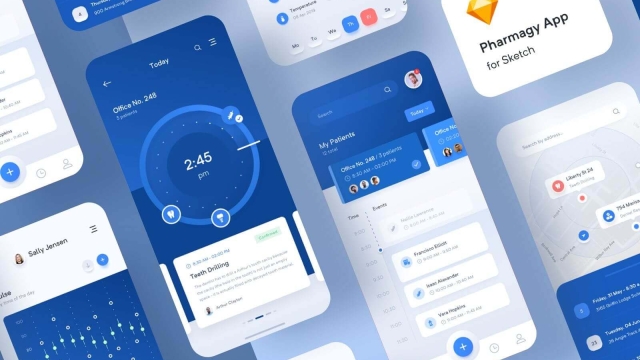Software design and development have become increasingly vital in our rapidly evolving technological landscape. With the proliferation of mobile devices and the growing dependency on mobile applications, the demand for innovative software solutions is at an all-time high. The art of software design and development encompasses a wide range of skills, from conceptualizing ideas to creating functional and user-friendly mobile apps. In this article, we delve into the world of software design and development, exploring the different types of mobile applications and how they are revolutionizing the way we interact with technology. Whether you’re a seasoned developer or simply curious about the intricate process behind creating mobile apps, join us as we unveil the secrets of software design and development, unlocking the potential for innovation in this ever-expanding field.
Custom mobile application development
Mobile App Development: An Introduction
In today’s digital age, mobile applications have become an integral part of our lives. From connecting with friends through social media to managing our daily tasks, mobile apps have revolutionized the way we interact with technology. Software design and development play a crucial role in creating these innovative solutions that empower us in our day-to-day activities.
Software design and development involve the process of conceptualizing, designing, and creating mobile applications that cater to the needs and demands of the users. It requires a combination of technical skills, creativity, and problem-solving abilities to bring an app idea to life. Whether it’s a simple utility app or a complex gaming platform, software design and development are the driving forces behind the success of mobile applications.
When it comes to mobile app development, there are different types of mobile applications that developers can focus on. From native apps that are specifically designed for a particular platform to hybrid apps that can run on multiple platforms, each type has its own advantages and considerations. Native apps provide a seamless and optimized user experience by leveraging the capabilities of a specific operating system, while hybrid apps offer cross-platform compatibility and easier maintenance.
Mobile applications have transformed industries and revolutionized the way businesses operate. They have enabled us to accomplish tasks on the go, access information with a tap of a finger, and connect with people across the globe. With the increasing demand for mobile apps, the field of software design and development continues to evolve, pushing boundaries and unlocking new possibilities.
In the next sections, we will delve deeper into the intricacies of software design and development for mobile applications. We will explore the different stages involved in the development process, best practices, and key considerations to ensure successful app creation. So, stay tuned to unravel the art and science behind building exceptional mobile applications.
Exploring Software Design and Development
Software design and development plays a crucial role in the creation of mobile applications. In this digital age, mobile apps have become an integral part of our lives, providing us with convenient solutions for various tasks and activities. Whether it’s for communication, entertainment, or productivity, mobile applications have revolutionized the way we interact with technology.
When it comes to software design and development for mobile apps, there are several key factors to consider. Firstly, understanding the unique requirements of different types of mobile applications is essential. Each category of mobile app, such as social media, gaming, or e-commerce, requires specific design and development approaches to meet the needs of its target audience.
Moreover, software design and development for mobile apps involves a combination of creativity and technical expertise. Designers and developers work collaboratively to create visually appealing and intuitive user interfaces while ensuring seamless functionality and performance. They strive to strike the right balance between aesthetics and usability, providing users with an engaging and satisfying experience.
Lastly, the process of software design and development for mobile apps is an iterative one. It involves multiple stages, including ideation, prototyping, implementation, testing, and optimization. Designers and developers constantly refine their work based on user feedback and changing market trends, aiming to deliver a polished and feature-rich application.
Overall, software design and development for mobile apps is a dynamic and intricate art form. By combining innovative ideas, technical skills, and user-centric approaches, designers and developers can unleash the true potential of mobile applications, creating impactful solutions that enhance our digital lives.
Types of Mobile Applications
There are various types of mobile applications that are designed and developed to cater to different needs and preferences of users. Let’s take a closer look at three popular categories of mobile apps:
Utility Apps: Utility apps are designed to provide specific tools or functionalities to users. These apps often serve practical purposes and help users with tasks such as managing finances, tracking health and fitness, or organizing their daily schedules. Examples of utility apps include banking apps, fitness trackers, and calendar applications.
Social Networking Apps: Social networking apps have become an integral part of our daily lives, connecting people from all around the world. These apps enable users to interact and communicate with each other, share content and media, and join communities based on their interests. Popular social networking apps include Facebook, Instagram, and Twitter, providing users with a platform to connect, share, and engage with others.
Entertainment Apps: Entertainment apps offer users a wide range of leisure and recreational activities. They are designed to provide entertainment and enjoyment through various mediums such as games, streaming platforms, or multimedia apps. Gaming apps like Candy Crush or Pokémon Go, video streaming apps like Netflix or YouTube, and music streaming apps like Spotify or Apple Music fall into the category of entertainment apps.
By recognizing the different types of mobile applications, developers can understand the specific requirements and expectations of users. This knowledge helps in crafting well-designed and functional apps that cater to the diverse needs of mobile users. Whether it’s a utility app for managing tasks, a social networking app for staying connected, or an entertaining app for leisurely activities, the possibilities for innovation in mobile app development are endless.



